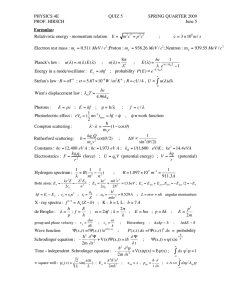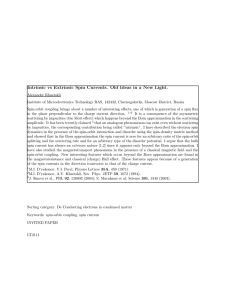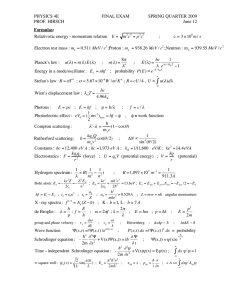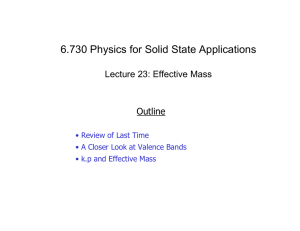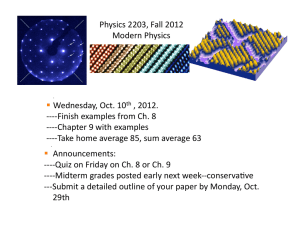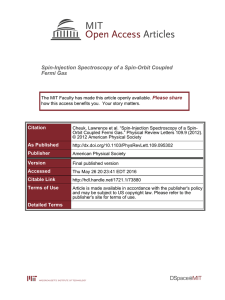PHYSICS 4E QUIZ 4 SPRING QUARTER 2009 PROF. HIRSCH
advertisement
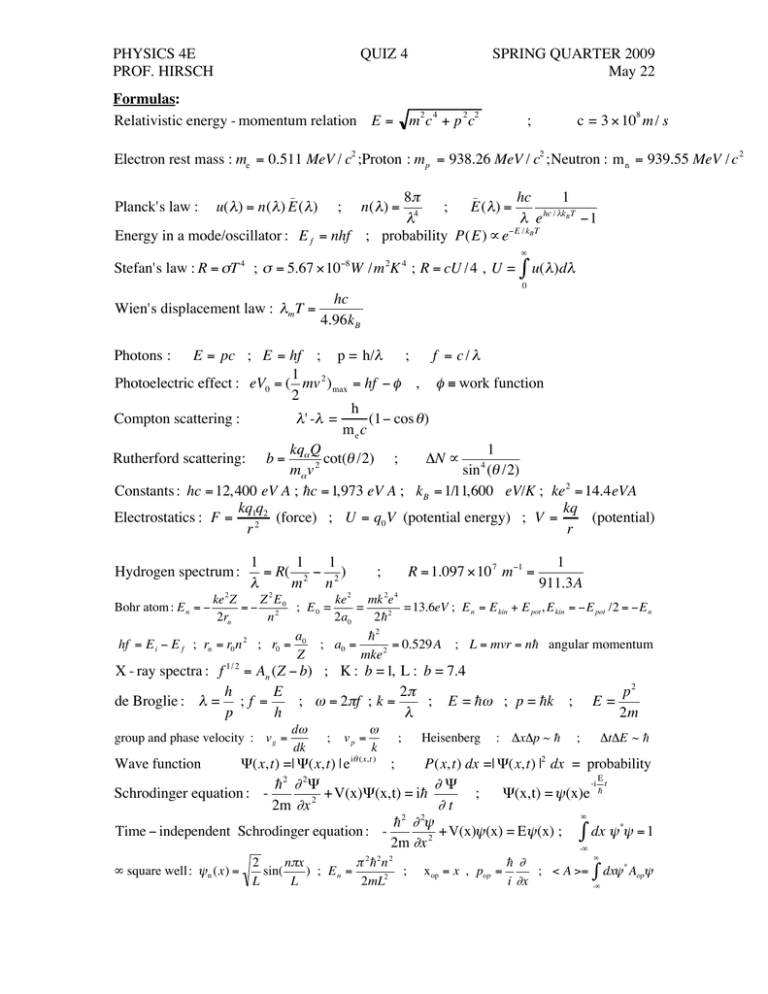
PHYSICS 4E PROF. HIRSCH QUIZ 4 Formulas: Relativistic energy - momentum relation E = SPRING QUARTER 2009 May 22 m2 c 4 + p 2 c2 c = 3 ! 108 m / s ; Electron rest mass : me = 0.511 MeV / c2 ;Proton : mp = 938.26 MeV / c2 ;Neutron : m n = 939.55 MeV / c 2 _ 8# hc 1 ; E ( ") = 4 hc / "kB T " " e $1 Energy in a mode/oscillator : E f = nhf ; probability P(E) " e#E / kB T _ Planck's law : u( ") = n( " ) E ( ") ; n( ") = & ! ! ! ! ! ! Stefan's law : R = "T 4 ; " = 5.67 #10$8 W /m 2K 4 ; R = cU /4 , U = 0 hc Wien's displacement law : "m T = 4.96k B Photons : E = pc ; E = hf ; p = h/! ; f = c/! 1 Photoelectric effect : eV0 = ( mv 2 ) max = hf " # , # $ work function 2 h Compton scattering : ! ' -! = (1" cos # ) me c kq Q 1 "N # 4 Rutherford scattering: b = " 2 cot(# /2) ; m" v sin ($ /2) Constants : hc = 12,400 eV A ; hc = 1,973 eV A ; k B = 1/11,600 eV/K ; ke 2 = 14.4eVA kq q kq Electrostatics : F = 12 2 (force) ; U = q0 V (potential energy) ; V = (potential) r r ! ! Hydrogen spectrum : Bohr atom : E n = " ! ! ! ! ' u(%)d% 1 1 1 = R( 2 # 2 ) " m n R = 1.097 $10 7 m#1 = ; 1 911.3A ke 2 Z Z 2E ke 2 mk 2e 4 = " 2 0 ; E0 = = = 13.6eV ; E n = E kin + E pot , E kin = "E pot /2 = "E n 2rn n 2a0 2h 2 hf = E i " E f ; rn = r0 n 2 ; r0 = a0 Z ; a0 = h2 = 0.529A ; L = mvr = nh angular momentum mke 2 X - ray spectra : f 1/ 2 = An (Z " b) ; K : b = 1, L : b = 7.4 h E 2$ de Broglie : " = ; f = ; # = 2$f ; k = ; E = h# ; p = hk ; p h " group and phase velocity : v g = d" dk ; vp = " k ; Heisenberg : #x#p ~ h E= p2 2m #t#E ~ h ; "(x,t) =| "(x,t) | e i# (x,t ) ; P(x,t) dx =| "(x,t) |2 dx = probability E -i t h2 " 2# "# Schrodinger equation : + V(x)#(x,t) = ih ; #(x,t) = $ (x)e h 2m "x 2 "t % h 2 # 2$ Time " independent Schrodinger equation : + V(x) $ (x) = E $ (x) ; & dx $ *$ = 1 2m #x 2 -% Wave function ! ! ! ! ! ! " square well : # n (x) = 2 n$x $ 2h2n 2 sin( ) ; En = ; L L 2mL2 x op = x , pop = h % ; < A >= i %x " * & dx# A # op -" PHYSICS 4E PROF. HIRSCH QUIZ 4 SPRING QUARTER 2009 May 22 Eigenvalues and eigenfunctions : Aop " = a " (a is a constant) ; uncertainty : Harmonic oscillator : "n (x) = Cn H n (x)e ! Step potential : R = ! (k1 " k2 ) 2 , (k1 + k2 ) 2 m$ 2 # x 2h #A = < A 2 > $ < A > 2 2 1 p 1 1 ; E n = (n + )h$ ; E = + m$ 2 x 2 = m$ 2 A 2 ; %n = ±1 2 2m 2 2 T = 1" R ; k= 2m (E " V ) h2 b % -2 # (x )dx Tunneling : ! " (x) ~ e -#x ; T ~ e -2#$x ; T~e a ; # (x) = 2m[V (x) - E] h2 # 2 h 2 n12 n 22 n 32 ( + + ) 2m L12 L22 L23 Spherically symmetric potential: "n,l,m (r,#, $ ) = Rnl (r)Ylm (#, $ ) ; Ylm (#, $ ) = f lm (# )e im$ r r r h # Angular momentum : L = r " p ; Lz = ; L2Ylm = l(l + 1)h 2Ylm ; L z = mh i #$ Z2 Radial probability density : P(r) = r 2 | Rn,l (r) |2 ; Energy : E n = !13.6eV 2 n 1 Z 3 / 2 $Zr / a 0 Ground state of hydrogen and hydrogen - like ions : "1,0,0 = 1/ 2 ( ) e # a0 " " #e eh Orbital magnetic moment : µ = L ; µz = #µB ml ; µB = = 5.79 $10#5 eV /T 2me 2me r 1 "e r Spin 1/2 : s = , | S |= s(s + 1)h ; Sz = msh ; ms = ±1/2 ; µs = gS 2 2me 3D square well : "(x,y,z) = "1 (x)"2 (y)"3 (z) ; E = ! ! ! ! ! r r r Total angular momentum : J = L + S ; | J |= j( j + 1)h ; | l " s |# j # l + s ; " j # m j # j r r "e r r r Orbital + spin mag moment : µ= ( L + gS ) ; Energy in mag. field : U = "µ # B 2m Two particles : "(x1, x 2 ) = + /# "(x 2 , x1 ) ; symmetric/antisymmetric Screening in multielectron atoms : Z ! Z eff , 1 < Z eff < Z Orbital ordering: 1s < 2s < 2p < 3s < 3p < 4s < 3d < 4p < 5s < 4d < 5p < 6s < 4f < 5d < 6p < 7s < 6d ~ 5f ! ! ! ! ! Justify all your answers to all problems Problem 1 (10 pts) A two-dimensional infinite square well with side lengths L1=L2=4A has 4 electrons. Assume the electrons don't interact with each other. (a) Find the ground state energy (in eV), taking into account that electrons are fermions with spin ½. (b) Give the degeneracy of the ground state (number of different states with the same energy). (c) Taking into account now that electrons interact, do you expect the total spin of the ground state to be zero or nonzero? Justify. (d) Answer the questions (b) and (c) for the case where L1=4A, L2=4.2A. Use h 2 /2me = 3.81 eV A 2 ! PHYSICS 4E PROF. HIRSCH QUIZ 4 SPRING QUARTER 2009 May 22 Problem 2 (10 pts) The n=3, l=2 radial wavefunction for an electron in a hydrogen-like ion is R(r) = Cr 2e"2r / a 0 where a0 is the Bohr radius and C is a constant. (a) Find the most probable r for this electron, in terms of a0. (b) Find the average r for this electron, in terms of a0. (c) Give the value of the radius of this orbit within Bohr theory and compare with the results of (a) and (b). Discuss similarities and differences. $ s! Use % drr se" #r = s+1 # 0 ! ! Problem 3 (10 pts) Boron has atomic number Z=5, and electronic configuration 1s22s22p1. (a) Give a qualitative explanation for why the ionization energy of boron, IB=8.3 eV, is lower than both the ionization energy of Be (Z=4, IBe=9.3 eV) and that of C (Z=6, IC=11.3 eV). (b) Calculate by how much (in eV) the energy of a Boron atom will change in an external magnetic field Bext=15T, ignoring spin-orbit coupling. Will the energy increase or decrease if Bext is (i) along the z direction, (ii) along the -z direction, or (iii) along the x direction? (c) Explain what are the consequences (if any) of spin-orbit coupling for the electronic states of the Boron atom in the absence of an external magnetic field. (d) Give an example of an atom (other than hydrogen) for which spin-orbit coupling does not affect the ground state. Justify all your answers to all problems
